Last updated on August 20th, 2011
Our site is reader supported, this means we may earn a small commission from Amazon and other affiliates when you buy through links on our site.
Pyracantha have quite a few pests which they are susceptable to being attacked by. These include, brown scale insects, aphids, leaf mining moths, caterpillars and whoolly aphids.
The good news is that all of these pests can be controlled using many techniques, including spraying with a good garden insecticide (available from most good nurseries and garden centres).
Brown Scale Insects on Pyracantha
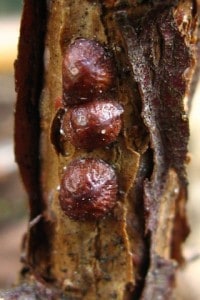
Pyracantha affected by Brown Scale usually show less vigour as the insects suck away the plants sap and sometimes the leaves on the plant start to curl.
Brown scale insects are part of the Scale Insect family, and are found on the underside of the Pyracantha leaves where they suck the sap from the veins of the shrub.
Brown scale insects are around 2-6mm (1/8in to 1/4in) long and have a shell-like formation which may look a little like miniature turtles. What you usually see (which can be all year round) are dead brown scale insects which are dead, they stay attached to the bark of plants and trees and these dead scale insect shells protect the eggs which are underneath them.
How to treat Brown Scale Insects on Pyracantha
Use a systemic insecticide which are available from most garden centres and nurseries. Systemic insecticides work by spraying the plant which then takes the poison into the plant and into its sap. This does not harm the plant but when the brown scale and other bugs feed from the plant they are poisoned and die. Pesticides we recommend are spray ornamental plants with Provado Ultimate Bug Killer concentrate (thiacloprid), Provado Ultimate Bug Killer Ready To Use, or (acetamiprid) Scotts Bug Clear Ultra concentrate, or (thiamethoxam) Westland Plant Rescue Bug Killer.
Apids on Pyracantha
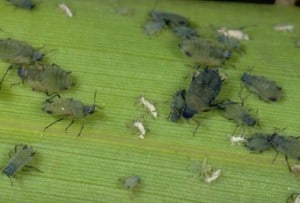
Aphids are one of the most prolific problem to everyday gardeners and farmers alike, they come in many forms which include, greenfly as commonly seen on rose bushes, blackfly, whitefly as well as over 400 more varieties of aphid which range in colour and size. They feed on the sap that is drawn up though the branches of Pyracantha.
Aphids are easy to spot and can be controlled with a variety of chemicals, non-chemical and natural ways, the good news is most aphids can be controlled by the same bug sprays available at most garden centres, although this is an effective ways to control them it can also have a bad affect on beneficial insects and wildlife which may also help control aphids and not do any harm in the garden. Careful spraying can limit the damage done by only spraying affected areas with a small hand spray.
Common Insecticide sprays available at garden centres include:
- Growing Success Fruit and Veg Bug Kill
- Growing Success Shrub and Flower Bug Killer
- Provado Ultimate Bug Killer (Available as concentrate or ready mix)
- Rose Clear (also effective against rust and fungus etc)
Whoolly Aphids on Pyracantha
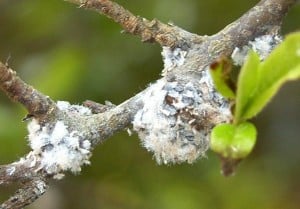
Whoolly Aphids can first seem like some sort of fungus but it is actually a type of aphid that sucks sap from your Pyracantha. They are brownish in colour but appear to be white and look a little like cotton wool giving it the name ‘Whoolly Aphid’.
As they suck the sap from shrubs and trees it will cause lumps to appear called knobbly galls on infected areas. Affected branches often need pruning away as they rarely recover from the attack. If left untreated they will kill a full grown plant leaving you no option but to remove it and plant another plant.
Controlling Whoolly Aphids on your Pyracantha
Any spray with Pyrethroids and Pyrethrin in will be effective. The chemical content of pesticides can be found on the bottles of chemicals at all garden centres and nurseries.
Caterpillars on Pyracantha
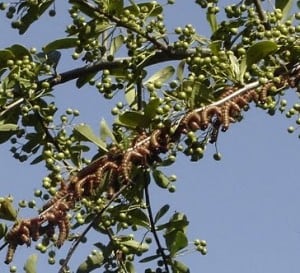
Caterpillars are probably one of the best known pest in the garden and come in lots of different colours from green to black with yellow stripes. The problem is they eat the leaves almost continuously, causing significant plant damage. When they are small they tend to live on the underside of leaves so are hard to spot but as they get bigger they tend to turn to the top of leaves.
Using pesticides to kill caterpillars
Caterpillars can be controlled with pesticides but if you use a contact one (one that needs to touch the caterpillar to kill it) make sure you spray the underside of leaves. Systemic pesticides are better as they are taken in by the plant which then acts as a poison in the plant and then when the caterpillars eat the leaves they get poisoned and die. To find a suitable pesticide head down to your local garden centre and look for one that says its effective against caterpillars.
Leaf Mining Moths on Pyracantha
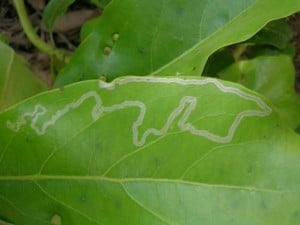
Leaf miners are the larvae of moths that tunnel just under the surface of leaves, they spend the winter tunneling through leaves until spring then the larvae emerage and become months. As they feed, they make distinctive winding trails or blotches on the leaves.

2 Comments
Hi, Just wondering if you can answer a question for me. I have a pyracantha growing up a wall(south Facing) near my front door. It’s berries are just beginning to develop. I have started to notice a real bitter smell but not dead animal in sight
and it seems to be covered in house flies/ blue bottles and the occasional wasp. This has never happened before. Wondering could you have an explanation for this? Many Thanks Tania
Hi Tania, this is not something I have ever heard of. If the plant is healthy I would think it would be fine, are you sure a fox has not buried something at the base of the Pyracantha maybe, this would explain the bluebottles as I not heard of this before. keep us updated if you solve this mystery.